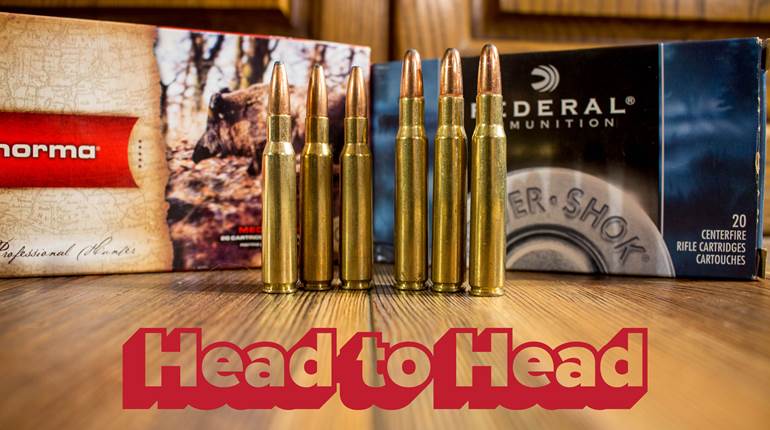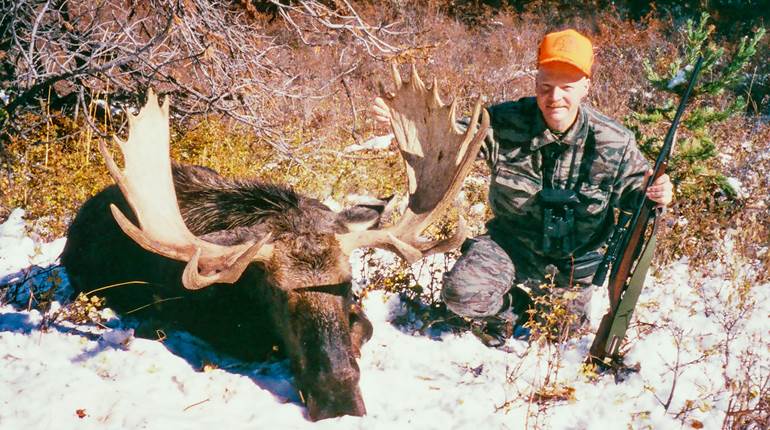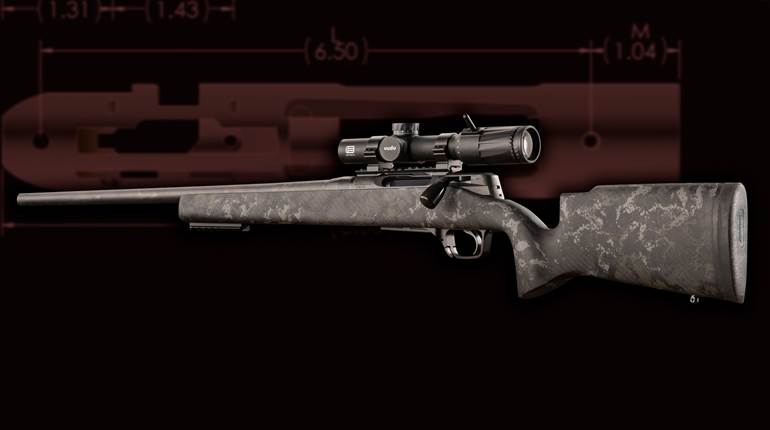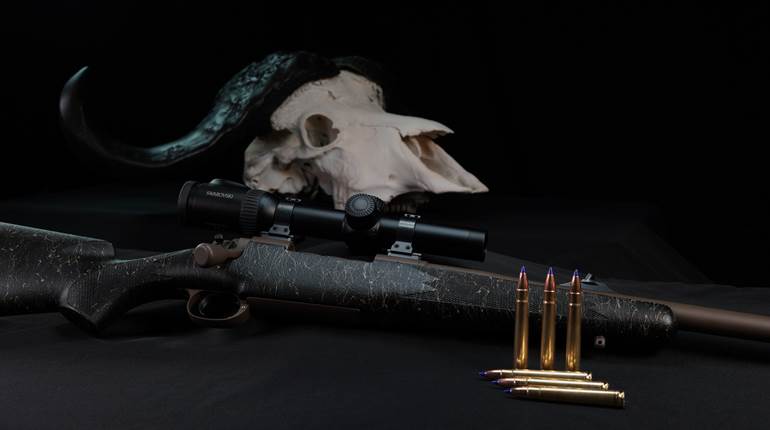
The 7 mm-08 Rem. cartridge was designed to replicate the performance of the 7x57 mm Mauser in a short-action chambering. Today, which one makes the better choice?
Back in the 1980s I spent a lot of time hunting wild pigs in the deep canyons of the old Dye Creek Ranch in northern California. I befriended the hunting manager, Mike Ballew, who went on to become the longtime director of the NRA Whittington Center. An astute rifleman, he was unashamed of hating recoil. The .257 Roberts was his idea of a perfect deer cartridge, but he guided a couple hundred pig hunts every year, and he respected big boars. On pig hunts, Mike carried a “big gun,” and to him that was a 7x57 mm Mauser. His was the first I ever saw in the field, but it wasn’t long before Mark Bansner built me my own 7x57 mm … and I’ve had at least one ever since.
It was also at Dye Creek that I saw the first use of the then-new 7 mm-08 Rem. Based on the .308 Win. case necked down, the 7 mm-08 is a ballistic twin to the time-honored 7x57 mm, so similar that for years I questioned its reason to exist. I was wrong about that; the 7 mm-08 has grown to become a popular hunting cartridge. Meanwhile, the 7x57 mm has not prospered, but it keeps rolling along. Both are good, mild-mannered and effective, but there’s little reason to own one of each. So, if you’re looking for an effective medium-range deer rifle, which should you choose?

History: 7x57 mm Mauser
Introduced by Mauser in 1892, the 7x57 mm, also called the 7 mm Mauser, is the oldest cartridge designed for smokeless powder that still retains a following. A rimless design, the 7x57 mm has a 0.473" head diameter, slight body taper and a 20°, 45’ shoulder. It was chambered to the ’93 Mauser, and adopted by Spain, thus America’s primary introduction to the cartridge came at the hands of Spanish troops in Cuba in 1898. We remember San Juan Hill as a glorious victory, but we forget that only 700 Spaniards inflicted more than 1,400 casualties on the attacking Americans. In a great coincidence of history, Transvaal President Paul Kruger purchased 37,000 ’95 Mausers in 7x57 mm, so the British, armed with .303s, faced 7 mm Mausers at about the same time, in the Second Boer War (1899-1902). The overconfident Brits were initially trounced by the sharpshooting Boers.

Like most successful military cartridges, the 7x57 mm quickly became a popular sporting cartridge. In 1907 the British firm of John Rigby gave the cartridge its third common name: .275 Rigby, based on the (inconsistent) British convention of naming cartridges by the land-to-land barrel diameter. In this guise the cartridge garnered its two most famous proponents: Walter Dalrymple Maitland “Karamoja” Bell and Jim Corbett.

Both wrote well and left awesome accounts of their deeds, but in both cases their use of the 7x57 mm Mauser is often exaggerated. It is true that the 7x57 mm, or .275 Rigby as he called it, was Bell’s favorite, but it is not true that he killed most of his 1,013 elephants with the 7x57 mm. He used a lot of different rifles, but he did love his .275s—between 1910 and 1923 he purchased six .275s from Rigby! Of course, he was using the original 173-gr. round-nose solid, and, of course, he was a consummate marksman, but he was also hunting in a different time. I love the 7x57 mm, but not for elephant! Jim Corbett had only one .275 (7x57 mm), presented to him after he killed the Champawat man-eater in 1907. Corbett used it for the rest of his life, but it is not true that he shot “all” his man-eaters with it, no more than Bell shot “all” his elephants with his .275s. Corbett did kill man-eating tigers with the rifle, but he preferred his .450/400 Nitro Express double. The .275 was his choice, however, for man-eating leopards and hunting for the pot. The 7x57 mm’s illustrious history hardly stops with Bell and Corbett, but it’s pretty hard to beat.

History: 7 mm-08 Remington
Now just 37 years old, the 7 mm-08 Rem. is young within the spectrum of center-fire sporting cartridges. I guess you could say we almost started our careers together, because when it was introduced in 1980, I was a young junior editor at Guns & Ammo magazine. We got in one of Remington’s Model 788 bolt-actions in 7 mm-08 Rem., and my colleague and buddy, Payton Miller, and I put it through its paces. The 788 was unlovely but spectacularly accurate. This one was a tack-driver!
A bit later, Payton and I were up at Dye Creek with the late Chub Eastman, then of Nosler Bullets. He was carrying a 7 mm-08 with an experimental projectile. Over time, we came to realize that the Ballistic Tip was a fast-opening bullet best-suited for deer, but you wouldn’t have known this on that day. Chub pasted a big boar, broadside on the shoulder, at about 100 yds. The 140-gr., bullet penetrated the near shoulder, wrecked the chest cavity, broke the far shoulder—and exited.
We were impressed. That said, I think I can say that, in the early 1980s, Payton and I shared the same impressions about the 7 mm-08: Nice little cartridge, but since it duplicated 7x57 mm performance, we didn’t understand its purpose. It’s not that the 7x57 mm was wildly popular at that time; it was not. Although popular in Europe, it was only occasionally chambered in domestic rifles. Factory loads were probably more available than today, but choices were limited and always conservative “because of older rifles still in use” (we’ll see that phrase again).
Perhaps we weren’t alone, because the 7 mm-08 was slow to catch on, and I didn’t give it much thought for years. In 2001, my eldest daughter, Brittany, decided to give hunting a try. I took her pig hunting with a .260 Rem., but she needed her own rifle. I settled on a Kimber in 7 mm-08 because it was more available, and 7 mm bullets offered more options. Brittany has worked wonders with her 7 mm-08, and it’s still her favorite. However, I wasn’t completely sold. When younger daughter Caroline got interested a decade later, she started with a borrowed youth model chambered for .260 Remington. I got her an identical rifle, a short-stocked Ruger M77 in .260 Rem. Unfortunately, this was one of those barrels that just wouldn’t shoot. I gave up and rebarreled it to 7 mm-08. This is Caroline’s infamous, hot pink, laminate-stocked Ruger—hard on the eyes but extremely accurate.
She’s used it a lot, but not exclusively. Her first African hunt was filmed for television, and we needed to use a “sponsorially correct” rifle. So we used a CZ 550 in 7 mm-08 with the stock shortened a bit. Caroline, Brittany and I all took game with that 7 mm-08. Although my daughters each have a 7 mm-08, both that CZ and the Model 788 Payton Miller and I used 37 years ago were “test rifles,” used and returned. I set up another for my niece’s husband, a Kimber Adirondack. So although I’ve shot a bunch of them, I’ve never laid claim to a 7 mm-08.
Wife Donna has been primarily a .270 Win. girl. For shooters of smaller stature there is little difference in recoil between the .270 and the 7 mm-08—also very little difference in performance on game. The .270 runs a bit faster, but the 7 mm-08 retains a slight edge in frontal area and bullet weight. Just recently we got our hands on a gorgeous Dakota Model 76 in 7 mm-08. It has a slightly short stock, perfect for her. Legally (per the dealer paperwork) it’s her rifle, so I can still say with a straight face that I’ve never owned a 7 mm-08, but I hope she’ll let me use this one.

Availability
The 7 mm-08 has grown in popularity and is now a standard chambering in short-action bolt guns, some semi-automatics and single-shots, and—of course—Browning’s BLR. Everybody makes ammunition, and unlike 7x57 mm Mauser loads, 7 mm-08 Rem. ammunition is loaded to the gills.
In the United States the 7x57 mm probably peaked during the 1930s—Jack O’Connor loved it before he latched onto the .270; his wife, Eleanor, remained a 7x57 mm fan. It is popular enough that it is in no danger of going away, but in new factory rifles it’s a rare bird, resurfacing every now and then, but usually as a limited run. It does remain popular in custom rifles, almost certainly because it reeks of nostalgia. In today’s ever-so-specialized world, however, the 7x57 mm has a problem: Very few bolt-actions are specifically sized to house it. Slightly too long to fit into a short-action, it works fine in a ’98 Mauser, sized to house the 8x57 mm with its original, long 226-gr. bullet. And it works just fine in any .30-’06 Sprg.-length action, but for those who care about such tidiness there is action space left over.
One could thus argue that the 7 mm-08 Rem. is a perfect fit for short actions, while the faster .280 Rem. is a better fit for .30-’06-length actions. This reality leaves the 7x57 mm the odd man out. But I don’t hear this argument very often. The 7x57 mm is neither wildly popular nor widely available, but neither is the .280 Rem. If availability of both rifles and ammunition is a driving factor, the edge must go to the 7 mm-08 Rem.
Velocity
In factory loads the velocity edge goes to the 7 mm-08. This is because of safety concerns; there are 1893 and ’95 Mauser actions still in use, and they are not as strong as later actions. This is consistently reflected in factory loads: Even in “fast” factory loads, such as Norma and Hornady’s Superformance, the 7x57 mm always lags behind the 7 mm-08.
Theoretically, however, the 7x57 mm Mauser should be faster. It has greater case capacity—55.6 grs. versus the 7 mm-08’s 52.2 grs. One can argue that the 7 mm-08’s shorter case is more efficient and yields more energy per grain of powder burned. However, in short actions it may not be possible to seat bullets farther out so as to utilize the 7 mm-08’s full capacity. This is not a problem with the 7x57 mm.
Back when I had my first 7x57 mm, published loads often exceeded 3000 f.p.s. with 140-gr. bullets. Also, decades ago, Rigby’s 140-gr., .275 Rigby load was quoted at 3000 f.p.s. (26" barrels were common then). Today’s manuals tell a different story. With better pressure-testing data and the constant specter of product liability, most current reloading manuals are more conservative. However, older cartridges such as the 7x57 mm suffer greatly, again “because of older rifles still in use.”
Put a different way, in older manuals the 7x57 mm would always win the velocity race, but current load data no longer reflects this. I made a call to a ballistician friend, and he conceded that the playing field isn’t level. For his company, 7x57 mm load data is capped at 50,000 p.s.i., while 7 mm-08 data is capped at 60,000 p.s.i. I won’t quote loads no longer published, but this doesn’t necessarily mean older data is unsafe, especially in strong modern actions such as the Ruger No. 1 and Remington Model 700 (both have been chambered to 7x57 mm). However, as examples: Hornady’s 8th Edition manual caps recommended 139-gr. 7x57 mm loads at 2700 f.p.s., and the heaviest recommended powder charge is 48.4 grs. (VIHT N-160). The same manual caps 139-gr. 7 mm-08 loads at 2900 f.p.s., with the heaviest recommended charge 49.9 grs. (H 414). Nosler’s 8th Edition manual suggests a max charge of 51.5 grs. of RL 19 yields 2892 f.p.s., the company’s fastest 140-gr. 7x57 mm load. The same manual suggests that maximum recommended charges of both RL 19 and Big Game propellants yield well over 2900 f.p.s. for a 140-gr. 7 mm-08 load. So, though I hate to admit it, in current loads the 7 mm-08 Rem. wins the velocity race in both handloads and factory ammunition.

Accuracy
I have rarely seen a 7x57 mm rifle that was a real tack-driver, and I have rarely seen a 7 mm-08 that was not. However, any given rifle can make a liar out of such statements. My Ruger No. 1 chambered for 7x57 mm is finicky. I was just about to give up on it, and then I found some loads it likes. My Todd Ramirez 7x57 mm is also picky, except that it’s never hopeless. It groups well enough with almost anything, and with certain loads it is a sub-m.o.a. rifle, but it took some looking to find those loads. Perhaps oddly, since it has a two-piece stock, the most accurate 7x57 mm I’ve had my hands on is a Dakota Model 10 single-shot roll-marked .275 Rigby, but it’s also a bit finicky. It hates Hornady’s 139-gr. InterLock .275 Rigby load, but it loves Hornady’s Superformance 139-gr. GMX load, consistently sub-m.o.a.
Even so, my sense is that the 7 mm-08 is the more accurate cartridge. It should be, if you subscribe to the short, fat theory of cartridge design. On average, few 7 mm-08s are likely to beat the best groups from the three 7x57s mm mentioned above, but the 7 mm-08 tends to be extremely accurate. Also, I’ve noticed that 7 mm-08 rifles are rarely finicky—usually they shoot well with most loads. Donna’s gorgeous Dakota Model 76 is one that makes a liar of this. It’s a finicky rifle, and although far from hopeless, finding the right load is still a work in progress. So one must be careful about stating absolutes, but I give the accuracy edge to the 7 mm-08.
Performance On Game
Since the 7 mm-08 is faster, it generates more energy, so it must be considered slightly superior on game. However, it is not enough faster that bullet performance is compromised, and great bullet performance is a consistent hallmark of both cartridges. I have not used either on elk or bears, but you certainly could use them for elk and black bear. I have used them on large-bodied red stags with perfect results, and we’ve used them on a wide array of African plains game up to kudu, wildebeest and zebra.
Daughter Brittany used her Kimber 7 mm-08 to take an eland with a single 140-gr. Partition, but despite Karamoja Bell’s legend, I think a 2,000-lb. animal is pushing the limits. Well, come to think of it, I used a 175-gr. Barnes solid to take a water buffalo with a single brain shot from the Ramirez 7x57 mm, but that’s also pushing it. I think a sensible limit is elk-sized game, and around 300 yds. is a sound range limit. This covers the majority of hunting situations, and despite previous mention of exotic beasts, most American hunters are deer hunters. Both the 7 mm-08 Rem. and 7x57 mm are fantastic deer cartridges, suitable under most conditions. Any difference isn’t enough to worry about; in the field they are ballistic equals.
In both cartridges I usually use 140-gr. bullets, deviating primarily only for specialized purposes. Most 7 mm bullets today are made with the understanding they might be used in fast magnums. At 7x57 mm and 7 mm-08 Rem. velocities the 140-gr. bullets perform wonderfully, and are faster and shoot flatter than heavier bullets. I wouldn’t hesitate to use a 140-gr. bullet from either cartridge on elk, but if a heavier bullet were desired, for instance for black bear, then the 7x57 mm has a slight advantage. In the 7 mm-08, heavy bullets are almost the exclusive province of handloaders, while Norma has a fast 7x57 mm (2641 f.p.s.) load for its tough 156-gr. Oryx bullet, and several firms still load the old 175-gr. bullet.

Which To Choose?
With performance on game about equal, I give the 7 mm-08 Rem. the nod on availability, velocity and accuracy. Light in recoil and long on performance, the 7 mm-08 can be housed in a trim short-action rifle, so I think it is the very best choice for youngsters and women of smaller stature—not just between it and the 7x57 mm, but pretty much across the board. It also isn’t a bad choice for brawny males who admire efficiency but don’t like getting kicked into next week. That said, there’s a reason why I’ve had one or another 7x57 mm for 30-odd years but I’ve never called a 7 mm-08 my own.
The 7x57 mm Mauser isn’t everybody’s cup of tea, but its disadvantages to the 7 mm-08 are slight. And if you place any value at all on history, tradition, nostalgia and charisma, then the 7x57 mm, 7 mm Mauser, and .275 Rigby—by any of these famous names—shines bright.
In terms of such preferences, rational thought doesn’t always have to prevail. So that’s why I prefer the 7x57 mm, even though I’d encourage you to take a hard look at the 7 mm-08 Rem.



















![Auto[47]](/media/121jogez/auto-47.jpg?anchor=center&mode=crop&width=770&height=430&rnd=134090788010670000&quality=60)
![Auto[47]](/media/121jogez/auto-47.jpg?anchor=center&mode=crop&width=150&height=150&rnd=134090788010670000&quality=60)
















